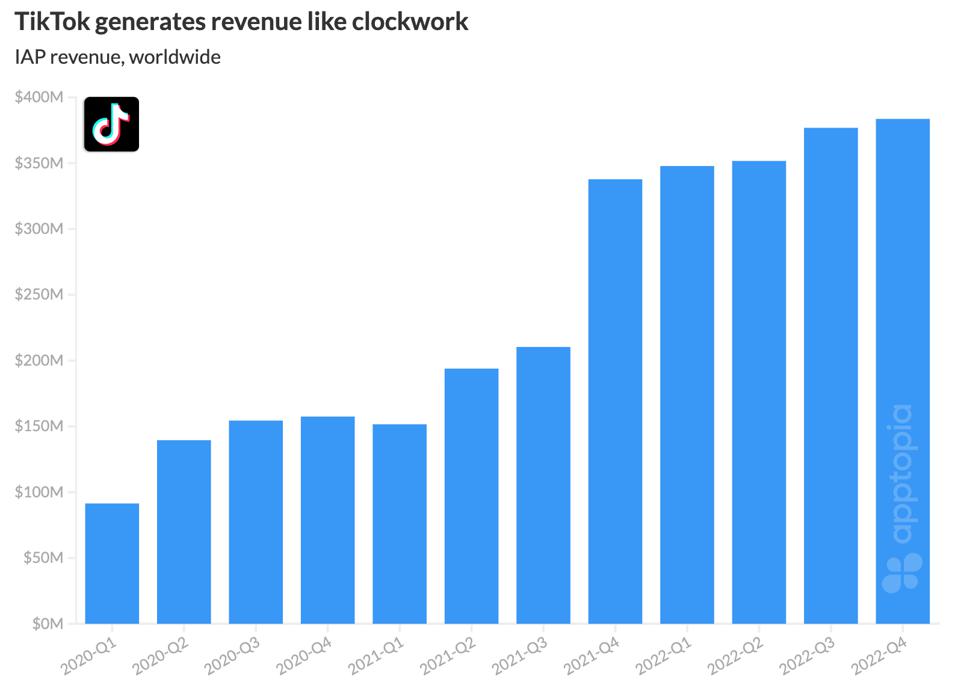Big social networks are pulling a massive revenue U-turn since Apple’s introduction of App Tracking Transparency. The user privacy feature, announced in 2020 and implemented in 2021, limits the data Facebook, TikTok, Snap and Instagram can use to target ads, so big social is making a collective push to direct user payments as an alternative to ad-focused monetization.
“Facebook, Instagram, TikTok, Twitter and Snapchat are still without paywalls but they now all offer products/services for charge via an in-app purchase (IAP), which Apple and Google get a cut of,” says Adam Blacker, a vice-president at mobile metrics company Apptopia. “TikTok, Facebook, Instagram, Snapchat, Twitter combined have grown quarterly IAP revenue 91% since Apple introduced ATT.”
Before iOS 14.5, which introduced Apple’s privacy protections, big social networks made almost all of their money via advertising.
More user data meant better-targeted ads, and better-targeted ads generated higher revenue multiples, especially for Facebook. With less data available, ad relevance has suffered and ad revenue has taken a hit. Collectively, big social appears to be trying to replace that lost revenue via direct payments from its users
Now Snap offers Snapchat+ for $40/year and Twitter offers Twitter Blue for $115/year. Both programs offer premium access to the platforms, and exclusive features for subscribers. Facebook and Instagram primarily offer payments for followers and fans to reward their favorite creators, or to boost the visibility of posts.
TikTok primarily focuses on creator rewards, and it’s doing better than all the other social networks combined.
“TikTok’s app revenue has grown for seven consecutive quarters,” Blacker says. “TikTok has generated $205 million more than Facebook, Instagram, Snapchat and Twitter combined, via IAP revenue, so far in 2023.”
Facebook is fighting back. Just last month, Mark Zuckerberg announced a paid verification program via his Instagram account. Users will pay $12/month via web payments or $15/month if they subscribe in-app to get a “Meta Verified” badge on their accounts, along with some safety improvements and additional visibility or reach on the platform. The company took in $56 million in 2022 in in-app purchases, according to Apptopia: down from highs in previous years, but showing improvement, especially on Instagram.
Instagram is hitting monthly in-app revenue of near $1 million in February. Snap’s monthly revenue is growing every month in 2023, hitting about $125,000/month. Twitter, meanwhile, pulled in almost $900,000 in February.
Small potatoes, perhaps, but also likely the beginning of something bigger.
TikTok is the real giant here, however.
In Q4 of 2022, TikTok generated over $350 million in in-app revenue. In 2020, the same quarter hit just $150 million. Both numbers pale before its full-year revenue from last year.
“TikTok has had IAPs [in-app purchases] since its very beginning and its app revenue last year was a whopping $1.5 billion,” Blacker says. “Its IAPs are similar to Facebook’s in that users pay for coins which can be used to tip and pay for things from their favorite creators.”
It’s important to note that in-app revenue is really only material for TikTok. Essentially, the small sums that Facebook, Instagram, Twitter, and Snap are bringing in via in-app purchase are rounding errors for those companies’ overall revenues. However, the example that TikTok is setting shows Facebook and the other social networks that in-app payments and purchases are a very real and very significant revenue opportunity, if they can make them work on their platforms.
It’s a revenue opportunity that doesn’t require selling ads or taking users’ data, and it’s also a revenue opportunity that — if consummated on the web and not in an app — the platforms can keep more of. Between 15% to 30% of in-app purchase costs typically go to the mobile platforms: Google and Apple.

